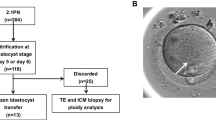Abstract
Embryos from two strains of mice were used to assess the effect of incubation temperature on pronuclear and twocell development to the morula/blastocyst (M/B) stage. Embryos from B6D2F2 and B6SJLF1 strains were cultured in medium M16 at either 37 or 39°C until 120 hr post human chorionic gonadotropin (hCG) or 0, 24, or 48 hr at 37°C and the remaining time at 39°C. Overall M/B development for pronuclear embryos was 0.6, 0, 32.3, and 52.4% for 0—96, 24—72, 48—48, and 96—0 hr at 37 and 39°C, respectively. Only 0—96 and 24—72 hr at 37 and 39°C were not different (P >0.10). Overall M/B development for two-cell embryos was 48.1, 78.1, and 98.0% for 0—72, 24—48, and 72—0 hr at 37 and 39°C, respectively. Percentage development at each time was different (P <.01) for each category. Additionally, the number of nuclei for morulae and blastocysts tended to be higher for embryos initiating culture at the two-cell stage compared to pronuclear embryos. The first cell cycle was most dramatically affected by a 2°C increase in incubator temperature. More advanced embryos can tolerate slight increases in incubator temperature more readily than pronuclear embryos.
Similar content being viewed by others
References
Pennycuik PR: A comparison of the effects of a range of high environmental temperatures and of two different periods of acclimatization on the reproductive performances of male and female mice. Aust J Exp Biol Med Sci 1967;45:527–532
Elliott DS, Burfening PJ, Ulberg LC: Subsequent development during incubation of fertilized mouse ova stressed by high ambient temperature. J Exp Zool 1968;169:481–486
Elliott DS, Ulberg LC: Early embryo development in the mammal. I. Effects of experimental alterations during first cell division in the mouse zygote. J Anim Sci 1971;33:86–95
Brinster RL: In vitro culture of mammalian embryos. J Anim Sci Suppl 1969;1:1–14
Boone WR, Shapiro SS: Quality control in the in vitro fertilization laboratory. Theriogenology 1990;33:23–50
Lenz RW, Ball GD, Leibfried ML, Ax RL, First NL: In vitro maturation and fertilization of bovine oocytes are temperature-dependent processes. Biol Reprod 1983;29:173–179
Quinn P, Barros C, Whittingham DG: Preservation of hamster oocytes to assay the fertilizing capacity of human spermatozoa. J Reprod Fert 1982;66:161–168
Whittingham DG: Culture of mouse ova. J Reprod Fert Suppl 1971;14:7–21
Sakkas D, Trounson AO, Kola I: In vivo cleavage rates and viability obtained for early cleavage mouse embryos in coculture with oviduct cells. Reprod Fert Dev 1989;1:127–136
Chatot CL, Ziomek CA, Bavister BD, Lewis JL, Torres I: An improved culture medium supports development of random-bred 1-cell mouse embryosin vitro. J Reprod Fert 1989;86:679–688
Loutradis D, John D, Kiessling AA: Hypoxanthine causes a 2-cell block in random breed mouse embryos. Biol Reprod 1987;37:311–316
Jackson KV, Kiessling AA: Fertilization and cleavage of mouse oocytes exposed to the conditions of human oocyte retrieval for in vitro fertilization. Fertil Steril 1990;51:675–681
Fissore RA, Jackson KV, Kiessling AA: Mouse zygote development in culture medium without protein in the presence of ethylenediaminetetraacetic acid. Biol Reprod 1989;41:835–841
Whitten WK, Biggers JD: Complete development in vitro of the pre-implantation stages of the mouse in a simple chemically defined medium. J Reprod Fert 1968;17:399–401
Gardner DK, Leese HJ: Concentrations of nutrients in mouse oviduct fluid and their effects on embryo development and metabolism in vitro. J Reprod Fert 1990;88:361–368
Lindquist S: The heat-shock response. Annu Rev Biochem 1986;55:1151–1191
Nieder GL: Analysis of proteins secreted by mouse embryos developing in vivo and in vitro. J Exp Zool 1989;252:134–142
Baumgartner AP, Chrisman CL: Analysis of post-implantation mouse embryos after maternal heat stress during meiotic maturation. J Reprod Fert 1988;84:469–474
Lavy G, Diamond MP, Pellicer A, Vaughan WK, Decherney AH: The effect of the incubation temperature on the cleavage rate of mouse embryos in vitro. J Vitro Fert Embryo Transfer 1988;5:167–170
Chatot CL, Lewis JL, Torres I, Ziomeck CA: Development of 1-cell embryos from different strains of mice in CZB medium. Biol Reprod 1990;42:432–440
Author information
Authors and Affiliations
Rights and permissions
About this article
Cite this article
Gwazdauskas, F.C., McCaffrey, C., McEvoy, T.G. et al. In vitro preimplantation mouse embryo development with incubation temperatures of 37 and 39°C. J Assist Reprod Genet 9, 149–154 (1992). https://doi.org/10.1007/BF01203755
Received:
Accepted:
Issue Date:
DOI: https://doi.org/10.1007/BF01203755




